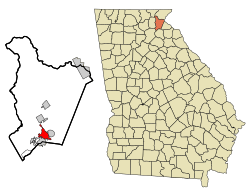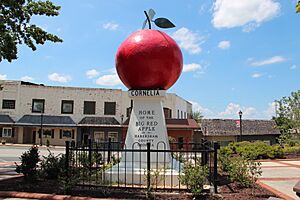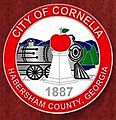Cornelia, Georgia facts for kids
Quick facts for kids
Cornelia, Georgia
|
||
|---|---|---|

Downtown Cornelia
|
||
|
||
| Nickname(s):
Home of the Big Red Apple
|
||

Location in Habersham County and the state of Georgia
|
||
| Country | United States | |
| State | Georgia | |
| County | Habersham | |
| Blaine | 1860 | |
| Cornelia | October 22, 1887 | |
| Government | ||
| • Type | Mayoral, elected democratically by popular vote. | |
| Area | ||
| • Total | 4.20 sq mi (10.87 km2) | |
| • Land | 4.15 sq mi (10.75 km2) | |
| • Water | 0.05 sq mi (0.12 km2) | |
| Elevation | 1,486 ft (453 m) | |
| Population
(2020)
|
||
| • Total | 4,503 | |
| • Density | 1,085.06/sq mi (418.95/km2) | |
| Time zone | UTC-5 (Eastern (EST)) | |
| • Summer (DST) | UTC-4 (EDT) | |
| ZIP code |
30531
|
|
| Area code(s) | 706 | |
| FIPS code | 13-19728 | |
| GNIS feature ID | 2404133 | |
Cornelia is a city in Habersham County, Georgia, United States. In 2020, about 4,500 people lived there. Cornelia is famous for having one of the world's largest apple sculptures. This huge apple sits on top of a tall monument.
The city was once the home of baseball legend Ty Cobb. He was born nearby and chose Cornelia for his retirement. Cornelia was also a base for making the 1956 Disney movie The Great Locomotive Chase. This film was shot along the Tallulah Falls Railway, which ran from Cornelia north to Franklin, North Carolina.
Contents
Exploring Cornelia's Location
Cornelia is located in the southern part of Habersham County. It shares a border with Mount Airy to the east. To the southwest, it borders Baldwin.
The city covers a total area of about 4.2 square miles (10.9 square kilometers). A small part of this area, about 0.05 square miles (0.1 square kilometers), is water.
A Look Back at Cornelia's History
Cornelia was first known as "Blaine." It started in the early 1870s when a railroad, the Charlotte Airline Railroad, reached this spot. The government of Georgia officially made it the "Town of Cornelia" in 1887.
Interesting Stories from the Past
Cornelia has many cool historical stories. Close to the city is the Wofford Trail. This trail was a place where many stagecoach robberies happened long ago. The very last railroad robbery in Georgia took place a few miles south of Cornelia, at a spot called Cagle's Crossing.
During the American Civil War, the people of Habersham County were very loyal to the Confederacy. This area was known as the "breadbasket of the Confederacy." It supplied thousands of bushels of wheat and corn to the soldiers.
After the Battle of Atlanta, some soldiers from William Tecumseh Sherman's army came to raid the county. But the Confederate Home Guard, made up of older men, stopped them. They met the Union soldiers at a narrow pass about four miles east of town. By making a lot of noise and smoke, they scared the Union soldiers away. This saved the area from being completely destroyed. Today, this event is called "The Battle of the Narrows."
Learning and Growth in Cornelia
Good schools have always helped Cornelia grow. In the early days, the town ran its own school system. Students had to bring their own books and pay a fee to attend. The school principal would order books directly from publishers in Atlanta.
One of the first schools was the Kimsey Institute. It was built on land given by T.J. Kimsey. For many years, this building was used as both a school and a church. As more students came, a new school was built in 1897. Professor A.E. Booth became the principal. He even added a special course to train teachers. This brought students from all over northeast Georgia.
In 1952, schools in Habersham County joined together. Elementary schools stayed in each town. However, two new high schools were built to serve different parts of the county. Before 1952, Cornelia Public School taught all students in Cornelia. The high school offered classes to prepare students for college and business. It also had sports, music, and speech classes. The first students graduated in 1899.
Local Industries and Economy
In the 1880s, German and Swiss immigrants used their skills to start a successful wine-making business. This industry thrived until a law stopped it. Other important industries for the area included cotton, timber, and lumber. The apple and peach industries were also very important.
In 1966, Riegel Textile built a large, modern textile factory in nearby Alto. Like any city, Cornelia had many businesses. Hotels were especially important for the city's growth in its early history.
The Famous Big Red Apple
Cornelia's Big Red Apple is a huge statue located at the old train depot downtown. It celebrates the importance of apples and apple growers in the county. This statue was built in 1925 from steel and concrete. It weighs about 5,200 pounds (2,359 kilograms) and stands 7 feet (2.1 meters) tall.
After World War I, "extension agents" became very important in northeast Georgia. These agents helped farmers move away from growing only one crop, like cotton. They taught farmers to grow many different crops. This way, if one crop failed, other crops could still provide income for the family. In Habersham and Gilmer counties, farmers started growing more apples and peaches.
This advice turned out to be very smart. In 1922, a tiny insect called the boll weevil began destroying cotton crops in Georgia. By 1924, cotton production had dropped by half. In 1925, the people of Cornelia realized that apples had saved their county. Apples helped them avoid the problems that hit other counties, where families had to move to cities like Atlanta.
The idea for the Big Red Apple statue was born then, partly thanks to the new Kiwanis Club. The statue was dedicated on June 4, 1926. Many important people attended, including Senator Walter F. George.
Later, in 1932, apple sales dropped a lot. Local farmers decided to put their apples in cold storage. They hoped to sell them the next spring. But sales did not improve. This meant farmers lost money on growing the apples and on storing them. By 1933, the apples that had saved the county earlier almost caused new problems.
Over the years, downtown Cornelia changed. When the railroad era ended, the old depot closed. But a recent renovation has brought the depot back to life. The Big Red Apple is now the main attraction for a yearly festival. This festival happens in the first week of October. There is also a 5K road race at the end of October.
Cornelia's Population Over Time
| Historical population | |||
|---|---|---|---|
| Census | Pop. | %± | |
| 1890 | 175 | — | |
| 1900 | 467 | 166.9% | |
| 1910 | 1,114 | 138.5% | |
| 1920 | 1,274 | 14.4% | |
| 1930 | 1,542 | 21.0% | |
| 1940 | 1,808 | 17.3% | |
| 1950 | 2,424 | 34.1% | |
| 1960 | 2,936 | 21.1% | |
| 1970 | 3,014 | 2.7% | |
| 1980 | 3,203 | 6.3% | |
| 1990 | 3,219 | 0.5% | |
| 2000 | 3,674 | 14.1% | |
| 2010 | 4,160 | 13.2% | |
| 2020 | 4,503 | 8.2% | |
| U.S. Decennial Census | |||
Population in 2020
In 2020, Cornelia had 4,503 people living in the city. There were 1,365 households and 871 families. Most residents were White, making up about 45% of the population. About 40% of the population identified as Hispanic or Latino.
Population in 2010
In 2010, the city had 4,160 people. There were 1,495 households. The population density was about 1,071 people per square mile. About 68% of the people were White, and 35% were Hispanic or Latino.
About 23% of the population was under 18 years old. About 17% of residents were 65 years or older. The average age in Cornelia was 37 years.
The average income for a household in Cornelia was about $31,111 per year. For families, the average income was about $42,041. About 13% of the population lived below the poverty line. This included 15% of those under 18 and 20% of those 65 or older.
Images for kids
See also
 In Spanish: Cornelia (Georgia) para niños
In Spanish: Cornelia (Georgia) para niños






